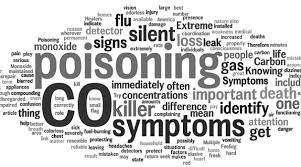Carbon monoxide poisoning is no joke. According to the U.S. Consumer Product Safety Commission, on average 170 Americans lose their lives each year to this odorless, invisible killer, which can strike when you least expect it.
Sources of Carbon Monoxide Poisoning
Carbon monoxide can’t be seen or smelled, but wherever fossil fuels are burned it is present in some quantity. During combustion oil, coal, natural gas, propane, kerosene, wood, charcoal and gasoline will all produce it.
Inside your home, possible sources of carbon monoxide exposure include:
• Gas furnaces
• Gas stoves
• Propane heaters
• Kerosene lamps
• Wood stoves
• Fireplaces
• Gas or propane generators
• Gas grills
• Automobiles
• Propane refrigerators
• Gas hot water heaters
Carbon monoxide produced in gas furnaces, stoves, wood stoves, fireplaces and water heaters is normally vented outside and will only cause problems if a leak occurs, or if venting outlets are blocked off.
Symptoms of Carbon Monoxide Exposure
The effects of carbon monoxide poisoning aren’t always noticeable immediately. In fact they are often vague enough that no one suspects what is happening until exposure has already reached red-alert levels.
If carbon monoxide exposure is continuous and significant, its side effects can include dizziness, sleepiness, muscle fatigue and lethargy, mental confusion, nausea, a dull throbbing headache, shortness of breath, loss of coordination and, at the extreme end, loss of consciousness and ultimately death.
Naturally the sooner you leave the premises when a carbon monoxide leak occurs the better your chances of escaping unscathed.
Symptoms of Carbon Monoxide Exposure
The effects of carbon monoxide poisoning aren’t always noticeable immediately. In fact they are often vague enough that no one suspects what is happening until exposure has already reached red-alert levels.
If carbon monoxide exposure is continuous and significant, its side effects can include dizziness, sleepiness, muscle fatigue and lethargy, mental confusion, nausea, a dull throbbing headache, shortness of breath, loss of coordination and, at the extreme end, loss of consciousness and ultimately death.
Naturally the sooner you leave the premises when a carbon monoxide leak occurs the better your chances of escaping unscathed.
Prevention Strategies for Carbon Monoxide Poisoning
If you have carbon monoxide sources in your home, carbon monoxide detectors (in the plural!) should be considered absolutely mandatory.
Carbon monoxide detectors are not perfect, especially if they aren’t installed in close proximity to possible sources of leakage. But if you locate them close to appliances that produce carbon monoxide and adjacent to occupied sleeping areas, their protective capacities will be maximized.
Nevertheless, with carbon monoxide poisoning an ounce of prevention is worth a truckload of detectors beeping after the fact.
To reduce the likelihood of exposure to this hidden threat, you should:
1. Never try to install gas-, oil- or wood-burning appliances on your own. Hire trained professionals to handle that task.
2. Arrange for regular check-up/maintenance visits from those same professionals. These check-ups should be performed on an annual basis.
3. Make sure your fossil fuel-burning appliances are installed in airy, well-ventilated locations.
4. Have a fireplace or wood-burning stove have your chimneys/vent pipes cleaned yearly, at the very least.
5. Call a service technician immediately if your gas appliance’s flame is yellow and flickering and soot buildup is heavy. This could indicate the presence of excessive carbon monoxide.
6. Never operate grills, automobiles, generators or fossil-fuel burning space heaters in enclosed or even semi-enclosed spaces, or near the doors and windows of your home.
7. Test or change the batteries on your carbon monoxide detectors every two or three months.
If you’re carbon monoxide detectors do go off, or if you suspect exposure based on your physical symptoms, evacuate the premises immediately and call 911 to report a carbon monoxide emergency. Once the all-clear has been given, contact your HVAC service provider and/or gas company and ask them to dispatch a technician to inspect your fossil fuel-burning appliances and the rest of your home to see if they can locate the source of the problem.
Carbon Monoxide Got You Worried? Why Not Play it Safe and Call All Air?
At All Air Heating Air Conditioning And Solar we know carbon monoxide leaks are a deadly serious topic. That’s why we’re always prepared to help you stay one step ahead of this frightening menace.
If you live in Lodi or the surrounding area and have a gas or oil furnace, please contact us and ask about our expert inspection and maintenance services. Include us in your family’s carbon monoxide protection plan and you won’t be sorry—but you will be safe.

